The Jumping Spider (ジャンピングスパイダー) is one of the most challenging and notable obstacles that was introduced with the course redesign after Nagano Makoto's kanzenseiha in SASUKE 17.
The objective of the Jumping Spider was a hybrid of the Spider Walk and the Jump Hang. Competitors were given a long runway to gain speed so as to jump straight up to the walls from a mini trampoline. Once they propped themselves between the walls of the Spider Walk portion, they must travel forward until they reached the halfway point of the Spider Walk, where they needed to climb an ascending portion and then traveled horizontally again to reach the end of the obstacle and dropped down onto a landing platform. The space between the walls was 1.2m, wide enough for the competitors' hands and feet to fit.
During its lifespan for ten tournaments, the obstacle was proven to be one of the toughest First Stage obstacles, as all of the SASUKE All-Stars (except Akiyama Kazuhiko) have failed at least one version of it.
SASUKE 19 Version
By far the hardest version of the Jumping Spider. Coincidentally, that tournament's version of the Flying Chute was also considered the hardest version of the Flying Chute.
To make the obstacle harder for the competitors, the producers raised the walls and put them farther from the trampoline. In addition, the run-up to the obstacle was severely shortened.
In order to get past this obstacle, competitors needed great agility and had to hit the trampoline perfectly in order to gain enough distance and height to reach the walls. Because of the extreme difficulty, it was just a challenge trying to reach the walls, let alone sticking to them. This obstacle was proven to be deadly for many competitors, as it took 39 competitors to fail before Okuyama Yoshiyuki finally got past it.

A comparison between Jumping Spider in SASUKE 19 (left) and SASUKE 18 (right)
SASUKE 20-24 Version
Because of SASUKE 19's extreme difficulty, the producers toned down the Jumping Spider in order to make the obstacle a little easier for the competitors to get past. To do this, they moved the walls vertically down, so it was at the same height as in SASUKE 18, but also the same distance away from the trampoline as in SASUKE 19. With the obstacle modified once again, this obstacle became one of only five obstacles to be modified in three consecutive SASUKE tournaments, along with the Flying Chute (SASUKE 18 to SASUKE 20), Vertical Limit (SASUKE 30 to SASUKE 32), Sidewinder R (SASUKE 31 to SASUKE 33), and Fish Bone (SASUKE 33 to SASUKE 35).
While more competitors were able to clear, the obstacle was still a very dangerous obstacle in the First Stage. Now, success came more if the competitor could stay on the walls.
In SASUKE 21, Luci Romberg became the first female competitor to complete the obstacle, followed by Shimada Hiroyo in SASUKE 22, Komiya Rie in SASUKE 23, and Kadoi Satomi in SASUKE 27 (albeit on a different version of the obstacle). However, all of these female competitors failed on the next obstacle, the Half Pipe Attack.
Not all competitors failed at the jumping portion of the Jumping Spider. In SASUKE 24 for example, Nagano Makoto committed a simple, but fatal mistake at the obstacle, when he made the dismount at the obstacle just before reaching the end, resulting in his feet suddenly slipping and causing him to fall into the water.

Akiyama Kazuhiko on the Spider Walk portion of the Jumping Spider, SASUKE 20
SASUKE 26-27 Version
After Urushihara Yuuji's kanzenseiha in SASUKE 24, the obstacle was removed and replaced with the much easier obstacle, the Bridge Jump. It returned for SASUKE 26 along with the Half Pipe Attack. This version of the obstacle was much higher relative to the trampoline than the post-SASUKE 19 version in Shin-SASUKE. It was also placed farther back from the trampoline almost to the SASUKE 19 length. This resulted in many failures of high-profile competitors including Tajima Naoya, Yamada Katsumi, Satō Hiromichi and Nagano Makoto. In the next tournament however, the length of the run-up was increased to the length of the original SASUKE 18 version, which made the obstacle much easier.
American Ninja Warrior Appearances
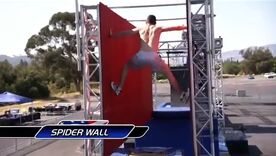
American Ninja Warrior 1's Spider Wall
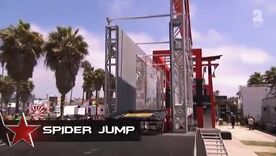
American Ninja Warrior 2's Spider Jump
The Jumping Spider appeared as the fourth obstacle during qualifying and semifinal on American Ninja Warrior 1 (called as the Spider Wall) and American Ninja Warrior 2 (called as the Spider Jump), with the distance between the trampoline and the walls was smaller, and the wall was arranged in a straight line, which made it similar to KUNOICHI 9 and KUNOICHI 10's Spider Walk.
A modified version of this obstacle (named as the Bouncing Spider) would later appear as the third obstacle on American Ninja Warrior 9 in Denver.
Las Vegas National Finals
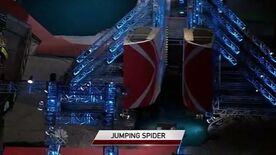
American Ninja Warrior 4's Jumping Spider in Stage One
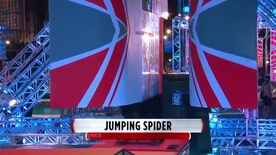
American Ninja Warrior 6's Jumping Spider in Stage One
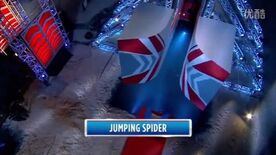
American Ninja Warrior 7's Jumping Spider in Stage One
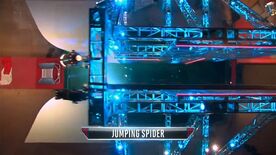
American Ninja Warrior 9's Jumping Spider in Stage One

American Ninja Warrior 10's Jumping Spider in Stage One
Later, the Jumping Spider appeared as the fourth obstacle in Stage One from American Ninja Warrior 4 until now, but the distance between the trampoline and the walls has increased to 4 feet.
Just like in SASUKE, the obstacle was proven to be deadly as usual, taking out some of the top competitors (e.g. Jesse La Flair, James McGrath, Ryan Stratis, Flip Rodriguez, Lance Pekus, Jamie Rahn, and Ian Dory).
Prior to achieving total victory on American Ninja Warrior 7, the Jumping Spider had been responsible for eliminating both Isaac Caldiero (on American Ninja Warrior 5) and Geoff Britten (on American Ninja Warrior 6) on their first seasons competing.
On American Ninja Warrior 6, Meagan Martin became the first female competitor to complete the obstacle, followed by Jessie Graff on the next season. Unlike the four mentioned Japanese female competitors above, Meagan Martin could complete the Half Pipe Attack, before timing out on the Warped Wall.
On American Ninja Warrior 9, a record 5 female competitors completed this obstacle (Barclay Stockett, Jesse Labreck, Allyssa Beird, Meagan Martin, and Jessie Graff).
On American Ninja Warrior 10, only 2 female competitors (Barclay Stockett, and Jesse Labreck) had completed the obstacle. While Meagan Martin shockingly fell on it.
On American Ninja Warrior 11, it was notable for making Sean Bryan injured his shoulder and had to withdraw.
Other Appearances
Ninja Warrior UK

Ninja Warrior UK's Spider Jump
During the first 2 seasons of Ninja Warrior UK, the Jumping Spider appeared as the fifth obstacle during:
- the finals's Stage 1 on Ninja Warrior UK,
- the semi-finals on Ninja Warrior UK 2.
Similar to its appearance on American Ninja Warrior 2, the obstacle was called as the Spider Jump, and the walls were arranged in straight line (similar to the Spider Wall/Spider Jump used on American Ninja Warrior 1 and American Ninja Warrior 2).
Australian Ninja Warrior
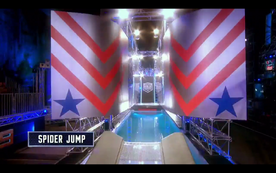
Australian Ninja Warrior's Spider Jump
The Jumping Spider (also called as the Spider Jump) appeared:
- as the fifth obstacle in Stage One on Australian Ninja Warrior,
- as the third obstacle in Stage Two on Australian Ninja Warrior 2, and
- as the eighth obstacle in Stage One on Australian Ninja Warrior 3.
The obstacle was very similar to the one used during the first 2 seasons of Ninja Warrior UK.
However, unlike on many other SASUKE/Ninja Warrior formats, competitors would be disqualified if they returned to the starting platform after failing to generate enough momentum to reach the wall.
SASUKE Vietnam
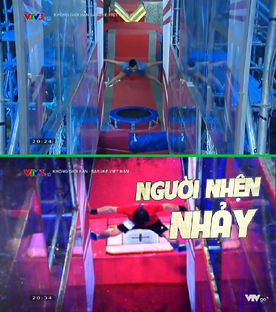
Comparison between the trampoline of the Jumping Spider on SASUKE Vietnam 1 and SASUKE Vietnam 2 (above) with the one on SASUKE Vietnam 3 afterwards (below)
The Jumping Spider (called locally as Tường Nhện Nhảy, Tường Nhện on SASUKE Vietnam 3 or Người Nhện Nhảy on SASUKE Vietnam 4 and SASUKE Vietnam 5) appeared as the fourth obstacle in Stage 1A from SASUKE Vietnam 1 to SASUKE Vietnam 5.
Similar with the original version from SASUKE, competitors were allowed to return to the starting platform if they failed to generate enough momentum to reach the wall.
However, on the first two seasons, the producers used a baby trampoline in order to make the jump to the walls easier for Vietnamese competitors. After Lê Văn Thực's total victory on SASUKE Vietnam 2, they replaced it with a normal trampoline from SASUKE.
The top part of the wall in the Spider Walk portion was covered with red sticker, and competitors would be disqualified if any part of them touched that (this rule would eventually be used on SASUKE Ninja Warrior Indonesia: International Competition). This rule came into play when so far, three competitors were disqualified after reviewing the tape:
- Nguyễn Minh Tuấn on SASUKE Vietnam 2,
- Cao Xuân Cương on SASUKE Vietnam 3, and
- Josh O'Sullivan on SASUKE Vietnam 5.
SASUKE Ninja Warrior Indonesia
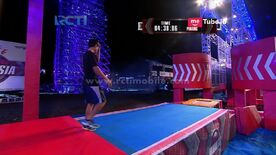
SASUKE Ninja Warrior Indonesia 2017's Jumping Spider in Semifinal Stage 2.
On SASUKE Ninja Warrior Indonesia 2017, the Jumping Spider appeared as the second obstacle during Semifinal Stage 2. Among the 27 competitors who attempted it, 10 of them failed to complete it (including SASUKE Ninja Warrior Indonesia finalist, Putra Waluya).
During SASUKE Ninja Warrior Indonesia: International Competition, the obstacle was modified with some parts of the walls being covered with red sticker, and the competitors were not allowed to touch them (a very similar rule used on SASUKE Vietnam). If they did so, they would be disqualified. As the result, it eliminated David Campbell from Team USA, who was the only competitor to failed at this obstacle.
Competitors' Success Rate
- All results based on the TBS/NBC broadcast and external information found
SASUKE
| SASUKE | Clears | Attempts | Percentage |
|---|---|---|---|
| 18 | 17 | 33 | 51.52% |
| 19 | 21 | 39 | 53.85% |
| 20 | 36 | 57 | 63.16% |
| 21 | 35 | 54 | 64.81% |
| 22 | 29 | 50 | 58% |
| 23 | 44 | 75 | 58.67% |
| 24 | 20 | 34 | 58.82% |
| 26 | 20 | 27 | 74.07% |
| 27 | 38 | 41 | 92.68% |
| Total | 260 | 410 | 63.41% |
American Ninja Warrior
| ANW | Clears | Attempts | Percentage |
|---|---|---|---|
| ANW4 | 62 | 86 | 72.09% |
| ANW5 | 33 | 71 | 46.48% |
| ANW6 | 35 | 62 | 56.45% |
| ANW7 | 57 | 78 | 73.08% |
| ANW8 | 34 | 49 | 69.39% |
| ANW9 | 53 | 64 | 82.53% |
| ANW10 | 43 | 55 | 78.18% |
| ANW11 | 56 | 62 | 90.32% |
| USA vs. Japan | 5 | 5 | 100% |
| USA vs. The World | 6 | 8 | 75% |
| USA vs. The World 2 | 3 | 8 | 37.5% |
| USA vs. The World 3 | 4 | 6 | 66.67% |
| USA vs. The World 4 | 6 | 7 | 85.71% |
| USA vs. The World 5 | 5 | 5 | 100% |
| USA vs. The World 6 | 5 | 6 | 83.33% |
| Total | 407 | 570 | 71.40% |
